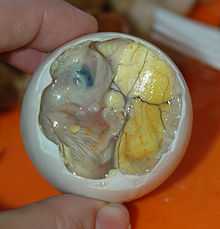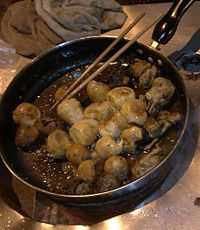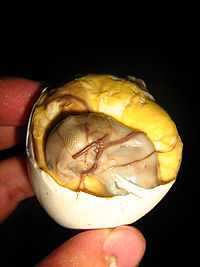Balut (food)

A balut (spelled standardized as balot) is a developing duck embryo (fertilized duck egg) that is boiled and eaten in the shell. It is commonly sold as streetfood in the Philippines. They are common food in countries in Southeast Asia, such as Laos (khai look ໄຂ່ລູກ in Lao), Cambodia (pong tia koon ពងទាកូន in Cambodian)[1] and Vietnam (trứng vịt lộn or hột vịt lộn in Vietnamese). They are often served with beer. The Tagalog and Malay word balut means "wrapped".
Preparation
In the Philippines, balut eaters prefer salt and/or a chili, garlic and vinegar (white or coconut sap) mixture to season their eggs.[2] The eggs are savored for their balance of textures and flavors; the broth surrounding the embryo is sipped from the egg before the shell is peeled, and the yolk and young chick inside can be eaten. All of the contents of the egg may be consumed, although the white albumen may remain uneaten depending on the age of the fertilized egg. This white albumen may have an unappetizing cartilaginous taste and is tough and rubbery in texture. In the Philippines, balut have recently entered haute cuisine by being served as appetizers in restaurants, cooked adobo style, fried in omelettes or even used as filling in baked pastries. In Vietnam, balut are eaten with a pinch of salt, lemon juice, plus ground pepper and Vietnamese mint leaves called rau ram (southern Vietnamese style). In Cambodia, balut are eaten while still warm in the shell and are served with nothing more than a little garnish, which is usually a mixture of lime juice and ground pepper.

A similar preparation is known in China as maodan (Chinese: 毛蛋; pinyin: máo dàn; literally: "feathered egg"), modan (Chinese: 末蛋; pinyin: mò dàn; literally: "end-stage egg"), wangjidan (Chinese: 旺雞蛋; pinyin: wàng jīdàn; literally: "flush egg") or huozhuzi (Chinese: 活珠子; pinyin: huózhūzi; literally: "living bead"). Chinese traders and migrants are said to have brought the idea of eating fertilized duck eggs to the Philippines. However, the knowledge and craft of balut-making has been localized by the balut-makers (mangbabalot). Today, balut production has not been mechanized in favor of the traditional production by hand. Although balut are produced throughout the Philippines, balut-makers in Pateros are renowned for their careful selection and incubation of the eggs.
Fertilized duck eggs are kept warm in the sun and stored in baskets to retain warmth. After nine days, the eggs are held to a light to reveal the embryo inside. Approximately eight days later the balut are ready to be cooked, sold, and eaten. Vendors sell cooked balut from buckets of sand (used to retain warmth) accompanied by small packets of salt. Uncooked balut are rarely sold in Southeast Asia. In the United States, Asian markets occasionally carry uncooked balut eggs. Alternatively, they can be mail-ordered. The cooking process is identical to that of hard-boiled chicken eggs, and baluts are eaten while still warm.

Duck eggs that are not properly developed after nine to twelve days are sold as penoy, which look, smell and taste similar to a regular hard-boiled egg. In Filipino cuisine, these are occasionally beaten and fried, similar to scrambled eggs, and served with a vinegar dip.
The age of the egg before it can be cooked is a matter of local preference. In the Philippines, the ideal balut is 17 days old, at which point it is said to be balot sa puti ("wrapped in white"). The chick inside is not old enough to show its beak, feathers or claws, and the bones are undeveloped. The Vietnamese often prefer their balut mature from 19 days up to 21 days, when the chick is old enough to be recognizable as a baby duck and has bones that will be firm but tender when cooked.
Outside Southeast Asia
Outside of Southeast Asia, balut is often considered a novelty taboo food having been featured on reality television shows, such as in season 1 of Bizarre Foods with Andrew Zimmern, or as part of eating challenges, such as on Fear Factor in 2002, the Hell's Kitchen in 2013, The Amazing Race Australia 2 and The Amazing Race Ukraine, Survivor: Palau, Survivor: China, and Survivor: Caramoan.[3][4]
In the United States, these eggs are sold at Asian or Vietnamese markets. However, to get the right age eggs and to ensure freshness, it is recommended that you buy them from a professional or an egg vendor at Asian farmer's markets.
Benefits
According to popular Vietnamese belief, these eggs are a nutritious and a restorative food for pregnant or delivering women.
See also
References
- ↑ Regional names.
- ↑ "What Is a Balut Egg?". The San Francisco Chronicle.
- ↑ 'Survivor: Caramoan': It's Corinne vs. Phillip when the tribes merge
- ↑ "Balut gets spotlight in New York".
Further reading
- Davidson, Alan (1999). "Balut". Oxford Companion to Food. Oxford University Press. p. 53. ISBN 0-19-211579-0.
External links
- How to make the Hawaiian version of Balut
- Balut : the ugly duckling embryo : The balut in Filipino culture
- Eating Balut: Going Too Far?
| Wikimedia Commons has media related to Balut. |
